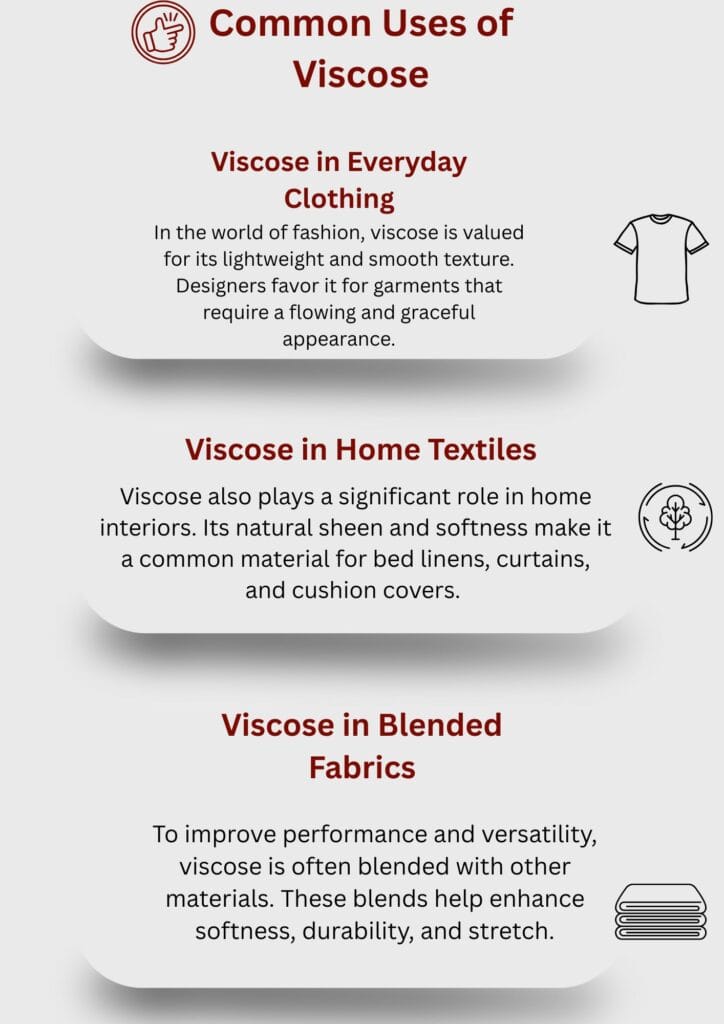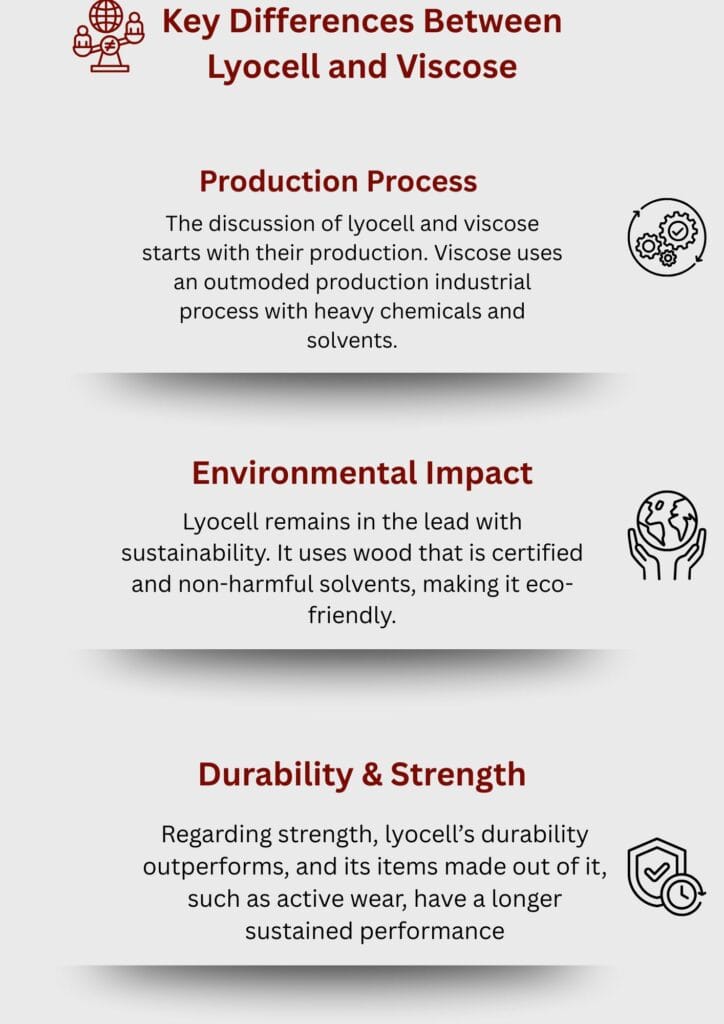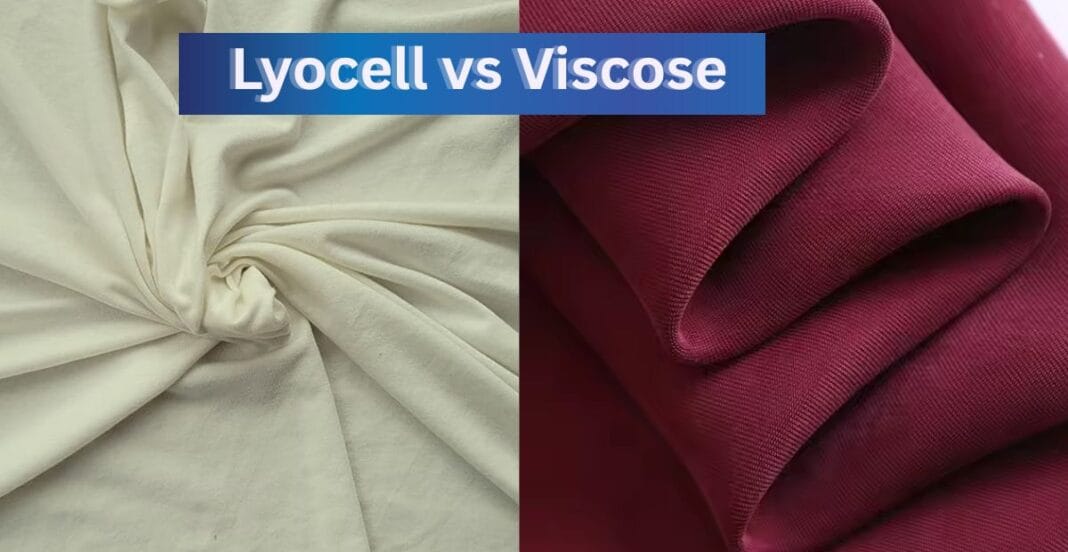Introduction
Both Lyocell and Viscose are semi-synthetic fibers derived from cellulose and typically procured from wood pulp. They are widely recognized in contemporary textiles for their softness and absorbance. The growing focus of the fashion sector on sustainability makes the discussion of Lyocell versus Viscose increasingly important.
Modern consumers are increasingly aware of their purchases. Analyzing these fabrics brings to light important factors such as comfort, sustainability, durability, cost-effectiveness, and overall value. While both fibers offer certain benefits, their production processes and environmental implications differ significantly. This article will examine the key attributes of each fiber and their performance.
What is Viscose?
Definition & Manufacturing Process
Viscose, also known as rayon, is a semi-synthetic fiber produced from the chemical dissolution of wood pulp. The pulp is treated with caustic soda and carbon disulfide, transforming it into a viscous solution, which is spun into fibers. Even though viscose utilizes natural resources, the chemical processes involved are quite detrimental.
These processes consume vast amounts of energy and result in toxic chemical byproducts. Manufacturing plants that fail to treat their waste are a high threat to the ecosystem. Even with these drawbacks, the soft and luxurious viscose fiber is widely used.
Common Uses of Viscose
You can find Viscose in:
- As part of dresses and blouse
- Lining and scarf
- Curtains and upholstery
- Lightweight tops and skirts
Her elegant home décor and garments are complemented by the silk-like finish and fluid drape of the viscose.

Pros of Viscose
The appealing features of viscose include:
- Just as cotton, viscose can breath, is soft, and
- affordable
- Luxurious to the touch, and drapes beautifully
- Comes in lots of bright shades and colors
The demand for fast and affordable clothes has made viscose popular.
Cons of Viscose
Like these advantages, viscose also has:
- Tears easily, especially when wet.
- Not durable, especially with routine washing
- Deforestation and water pollution
- Harsh chemicals used in manufacturing eco-systems
These environmental concerns are critical to many consumers.
What is Lyocell?
Definition & Manufacturing Process
Like viscose, lyocell is made from wood pulp, but it employs a closed-loop production system. In this system, waste water and solvents, such as N-Methylmorpholine N-oxide, are recycled and reused. As a result, lyocell has softer fibers and more sustainable.
This type of production makes lyocell some of the most eco-friendly textiles. Unlike viscose, lyocell is not made with toxic by-products and is manufactured under stricter environmental standards.
Popular Types of Lyocell
Lenzing is well-known for their TENCEL™ brand, the first-ever TENCEL™ lyocell fiber. It is a lyocell fiber that is branded, and is used by sustainable brands since it is certified sustainable. TENCEL™ lyocell is also widespread in luxury activewear brands, premium bedding, and luxury basics.
Pros of Lyocell
The advantages of lyocell include:
- Completely biodegradable and compostable
- Breathable and moisture-wicking
- Stronger than viscose even when wet
- Gentle on the skin and hypoallergenic
- Made from FSC certified wood
These benefits also reclaimed lyocell as one of the frontrunners in sustainable textiles.
Cons of Lyocell
Nevertheless, the below disadvantages still make lyocell los its appeal:
Disadvantages of lyocell include:
- Higher prices than viscose
- Low availability in discount retailers
- Gentle washing for higher-maintained quality.
However, the sustainable properties mean that, per many industry insiders, justify the higher price point.
Key Differences Between Lyocell and Viscose

Production Process
The discussion of lyocell and viscose starts with their production. Viscose uses an outmoded production industrial process with heavy chemicals and solvents. In contrast with viscose, lyocell uses a more efficient method called a closed-loop system, meaning that it recycles his solvents and creates a smaller carbon footprint.
Because of their production processes, these two fabrics differ substantially in their carbon footprints.
Environmental Impact
Lyocell remains in the lead with sustainability. It uses wood that is certified and non-harmful solvents, making it eco-friendly. Viscose, however, uses wood that is not certified, contributing to deforestation and pollution, making it far less eco-friendly. Furthermore, viscose plants in certain regions have been linked to china-grade water pollution.
As eco-friendly fabrics and materials become a more of market focus, lyocell has risen in prominence.
Durability & Strength
Regarding strength, lyocell’s durability outperforms, and its items made out of it, such as active wear, have a longer sustained performance pendant compared to viscose products that stretch when wet.
As a long-term product lyocell offers greater and lasting performance.
Breathability & Moisture Absorption
While both materials have good ventilation, lyocell outperforms viscose in the realm of moisture drawing. It ensures you stay dry and cool by drawing moisture away. This is advantageous during a workout and in hot weather regions.
While viscose has a soft texture, it has the disadvantage of sticking to the damp skin.
Cost
The production and purchasing viscose are less costly than other products. For this reason, it is favored by fast fashion brands. In contrast, lyocell is more expensive has an eco-friendly production process, but it has better quality and more durability than viscose.
From an overall perspective, viscose is better for spending-minded consumers and more beneficial to them in a short period.
Uses in Fashion & Textiles
Viscose is a favorable choice to make skirts and dresses, as well as linings because of its silky drape. However, lyocell is utilized in:
- Sportswear
- Lounge and leisure wear
- Eco-friendly luxury bedding
- Children clothes
These sectors benefit from its strength and breathability.
Sustainability Comparison: Lyocell vs Viscose and the Planet
Viscose’s Environmental Issues
Viscose is associated with:
- Deforestation
- Toxic chemical waste
- Air and water pollution
- Endangering flora and fauna and other ecosystems
These issues have brought scrutiny and demands for better governance on the subject.
Lyocell’s Eco-Friendly Edge
Lyocell distinguishes itself because of:
- Closed-loop solvent recycling
- Lower emissions
- Water conservation
- Use of renewable raw materials
Green sealed lyocell products, as with FSC-certified and EU Ecolabel, bring comfort to eco-conscious consumers.
Certifications to Look For
To ensure you’re buying responsibly, check for:
- OEKO-TEX®: Ensures the fabric is free from harmful chemicals
- FSC: Confirms sustainable forestry practices
- EU Ecolabel: Recognizes overall environmental excellence
Comfort & Performance: Which Feels and Wears Better?
Softness:
Both fabrics are soft and smooth, but lyocell has a silkier touch with a firmer feel. Unlike lyocell, viscose does not maintain softness and may pill or become rough with repeated washing.
Wrinkling & Care:
Lyocell does not become misshapen as easily as viscose does, making it less prone to wrinkles. Viscose not only is prone to wrinkles, but also requires frequent ironing. Laundering lyocell also requires less energy, making it more environmentally-friendly than viscose.
Hypoallergenic Qualities:
While both fabrics are suitable for sensitive skin, lyocell is more effective because of its moisture-wicking and antibacterial properties. Viscose, although breathable, may irritate skin due to chemical residues.
Price & Availability: Lyocell vs Viscose in the Market
Why Lyocell Costs More
Lyocell’s higher cost is due to:
- Sustainable practices
- Closed-loop production
- Renewable raw materials
- Premium Performance
Each stage of its creation is more regulated and environmentally conscious.
Is the Price Worth It?
If we consider value for the money, ethical morality, and the product’s durability, then the answer is definitely yes. Although viscose may be cheaper, it is less durable and considerably more harmful to the environment.
In the case of quality basics, lyocell gives better returns in the longrun.
Which One Should You Choose?
Select Viscose If,
- You are looking to buy reusable fashionable wear for limited use and are budget constrained
- You are looking for elegant formal drapes for formal wear.
- You are cash strapped.
Choose Lyocell If:
- You are looking for long-term sustanability.
- You are in dire demand for durable clothing that is also breathable.
- You are buying a bedding, baby clothes, or exercise clothes.
In the longrun, the choice between purchasing lyocell vs viscose depends on whether one chooses short-term benefits, lower cost, or long-term investment in sustainability.
Common Misconceptions Debunked
Not all Rayon is Created Equal
This statement is untrue. As types of rayon, viscose, modal, and lyocell are all distinct with regard to production techniques and sustainability. Of the three, lyocell is the most sophisticated and sustainable.
“Viscose is a Natural Fabric”
While viscose originates from wood pulp and is semi-synthetic, the chemical treatment required to process wood pulp to viscose is extensive. This, coupled with viscose’s drapability, makes viscose a very controversial fabric.
Origin of Sustainable Fabrics: The Surge of Lyocell
Venture innovation within the fabric space is largely related to eco-friendly ingenuity. Other sustainable brands like Patagonia, Allbirds and Reformation, are opting to use lyocell and TENCEL™ lyocell for their collections.
The sustaining practices are not a fad, rather, they have become the norm. The combination of stricter policies and consumer’s lyocell is poised to be a popular fabric choice
Conclusion:
In this comparison, lyocell is the chosen fabric for more eco-conscious consumers. Opting to not compromise on sustainability and durability, lyocell offers a more expensive option to viscose’s affordable and softer counterpart.
Select viscose where the effortless drape and price are priorities.
Choose lyocell for comfort, durability and reduced environmental impact.
In the end, the preference is dictated by the consumer’s personal values, lifestyle, and their desired impact on sustainable fashion.


